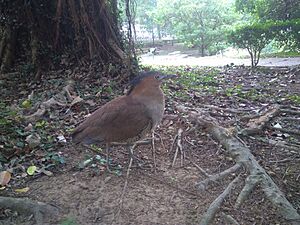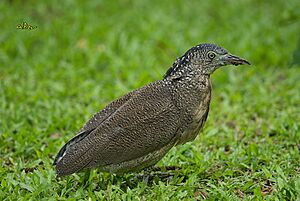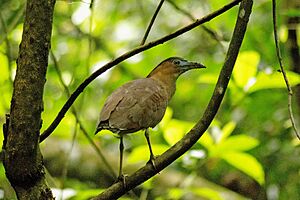Malayan night heron facts for kids
Quick facts for kids Malayan night heron |
|
|---|---|
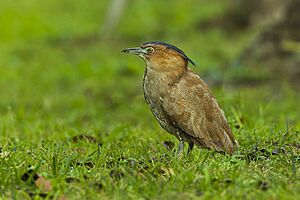 |
|
| Conservation status | |
| Scientific classification | |
| Genus: |
Gorsachius
|
| Species: |
melanolophus
|
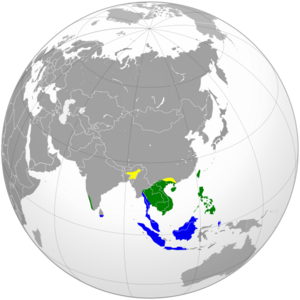 |
|
| Range of G. melanolophus Breeding range Resident range Wintering range | |
The Malayan night heron is a medium-sized bird. It is also called the Malaysian night heron or tiger bittern. You can find these birds in southern and eastern Asia. Its scientific name is Gorsachius melanolophus.
Contents
Where Malayan Night Herons Live
The Malayan night heron lives in many countries. These include India, Sri Lanka, Brunei, Nepal, Bangladesh, Myanmar, Cambodia, Laos, Vietnam, Thailand, Malaysia, Singapore, China, Indonesia, the Philippines, Taiwan, and Japan. Sometimes, a bird might fly far away from its usual home. This is called being a vagrant. Malayan night herons have been seen as vagrants in Palau and Korea. One was even found on Christmas Island, Australia.
Malayan Night Heron Habitats
These herons like to live in forests. They also live near streams and marshy areas. In Japan, more herons were found in forests that were not disturbed by people. This shows they prefer quiet, natural places.
What Malayan Night Herons Look Like
The Malayan night heron is about 48 cm (19 in) long. Its wings can spread out to about 86 cm (34 in). It has a strong body and a short beak.
Malayan Night Heron Colors
Its neck and chest are a reddish-brown color. You can see streaks going down the middle of its neck to its chest. The top part of its body is a chestnut brown. It has wavy patterns on its feathers. The flight feathers, which help it fly, are blackish. The top of its head is black, and its chin is white. Its eyes are yellow, and its beak is black. Its legs are greenish.
Young Malayan Night Herons
Young herons, called juveniles, look a bit different. They are grayish to reddish-brown. They have spots and wavy patterns all over their bodies.
Differences Between Males and Females
During the breeding season, male herons can look a little different from females. Males might have deeper blue skin around their eyes (called lores). They might also have a longer crest on their heads. Males develop these blue lores about 30 to 60 days before they find a mate. Females usually have bluish-green lores when they arrive at the breeding areas. As the birds sit on their eggs, the colors around their eyes fade. They change from bluish-green to green, then to grayish-green. If a pair lays eggs a second time, their lores are not as brightly colored.
Malayan Night Heron Behavior
Malayan night herons usually like to be alone. They rest in trees during the day. At night, they come out to feed in open areas. They seem to build their nests by themselves. They do not usually nest in large groups with other waterbirds. In Taiwan, some nests are even found close to city buildings. These birds might feed on earthworms and frogs in open areas near buildings.
Breeding and Reproduction
Sometimes, young herons that are not fully grown try to break up adult pairs. It has also been seen that young herons might pair up with adults. However, their nests might not be built very well. In one case, people helped a young-adult pair by building a base for their weak nest. A study in Taiwan found that four out of six breeding pairs were made of a young heron and an adult. This suggests that there are not many adult breeding herons in Taiwan. Even young herons seem to be able to reproduce.
Calls and Sounds
The Malayan night heron has a deep "oo" sound for its territory call. It also makes rough croaking sounds. Sometimes, it makes sounds like "arh, arh, arh."
What Malayan Night Herons Eat
The most common foods for these herons are earthworms and frogs. They will sometimes eat fish too. Scientists have studied their pellets, which are undigested food they spit out. These pellets have shown that they also eat:
Pellets from breeding birds in Korea contained earthworms, snails, and cicadas. One time, a Malayan night heron was seen eating a brown anole lizard.
Malayan Night Heron Conservation
The Malayan night heron lives in a very large area. There are between 2,000 and 20,000 of these birds in the world. We do not know if their numbers are going up or down. However, their population is not considered to be in danger right now. This means they are not listed as a vulnerable species.



